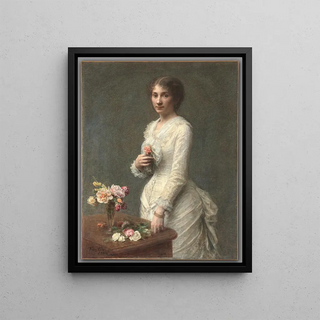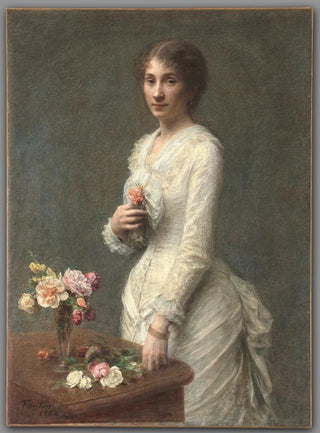Art print | Madame Lerolle - Henri Fantin-Latour


View from behind

Frame (optional)
At the heart of the late 19th century, the art world experiences an unprecedented effervescence, where Impressionist and Realist movements intersect, giving rise to iconic works. Among these creations, "Madame Lerolle" by Henri Fantin-Latour stands out for its elegance and delicacy. This piece, depicting the artist's wife, embodies not only feminine beauty but also the intimacy of human relationships. The painting, both personal and universal, immerses us in a gentle, contemplative atmosphere, inviting viewers to reflect on the nature of love and beauty.
Style and uniqueness of the work
Fantin-Latour's style is characterized by an impressive mastery of colors and textures, which is evident in "Madame Lerolle." The soft palette, dominated by pastel tones, creates a soothing ambiance, while the subtly diffused light on the model's face accentuates her pensive expression. This art print also distinguishes itself through its balanced composition, where each element finds its place harmoniously. The blurred background, evoking a dreamlike atmosphere, highlights the central figure, making her almost timeless. Madame Lerolle's posture, both relaxed and thoughtful, conveys a psychological depth that invites introspection. Fantin-Latour, as a portrait artist, succeeds in capturing not only the appearance but also the soul of his subject, a feat that gives the art print an undeniable singularity.
The artist and his influence
Henri Fantin-Latour, born in 1836, is a multifaceted artist. Initially known for his still lifes, he gradually turned to portraiture, becoming a witness to his era. His proximity to emblematic figures of the Impressionist movement, such as Claude Monet and Édouard Manet, enriched his artistic approach. However, Fantin-Latour stands out for his unique style, which blends realism and Impressionism, offering a personal and poetic vision of everyday life. His influence extends beyond his time, inspiring many contemporary and future artists. Through works like "Madame Lerolle,"

Matte finish

View from behind

Frame (optional)
At the heart of the late 19th century, the art world experiences an unprecedented effervescence, where Impressionist and Realist movements intersect, giving rise to iconic works. Among these creations, "Madame Lerolle" by Henri Fantin-Latour stands out for its elegance and delicacy. This piece, depicting the artist's wife, embodies not only feminine beauty but also the intimacy of human relationships. The painting, both personal and universal, immerses us in a gentle, contemplative atmosphere, inviting viewers to reflect on the nature of love and beauty.
Style and uniqueness of the work
Fantin-Latour's style is characterized by an impressive mastery of colors and textures, which is evident in "Madame Lerolle." The soft palette, dominated by pastel tones, creates a soothing ambiance, while the subtly diffused light on the model's face accentuates her pensive expression. This art print also distinguishes itself through its balanced composition, where each element finds its place harmoniously. The blurred background, evoking a dreamlike atmosphere, highlights the central figure, making her almost timeless. Madame Lerolle's posture, both relaxed and thoughtful, conveys a psychological depth that invites introspection. Fantin-Latour, as a portrait artist, succeeds in capturing not only the appearance but also the soul of his subject, a feat that gives the art print an undeniable singularity.
The artist and his influence
Henri Fantin-Latour, born in 1836, is a multifaceted artist. Initially known for his still lifes, he gradually turned to portraiture, becoming a witness to his era. His proximity to emblematic figures of the Impressionist movement, such as Claude Monet and Édouard Manet, enriched his artistic approach. However, Fantin-Latour stands out for his unique style, which blends realism and Impressionism, offering a personal and poetic vision of everyday life. His influence extends beyond his time, inspiring many contemporary and future artists. Through works like "Madame Lerolle,"






